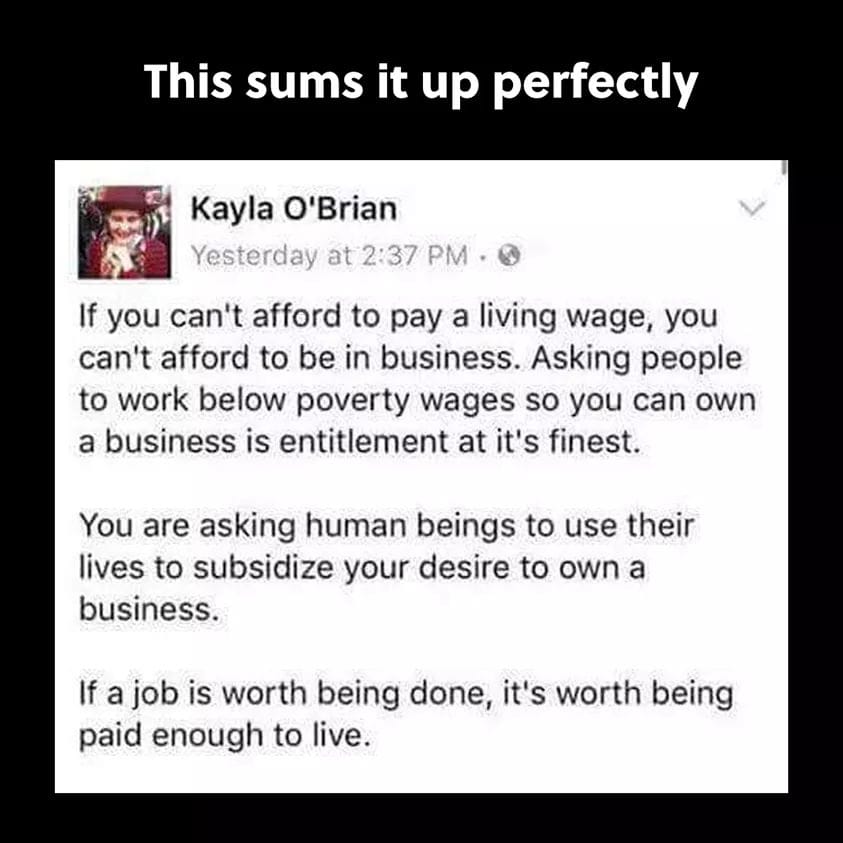“If you can’t pay $15 an hour you should go out of business”. Actually, no.

Chances are that you have come across a statement like this in a discussion about the minimum wage. I dealt with this particularly rotten argument back in 2017, when Minneapolis live music venue, bar, and restaurant, Whiskey Junction closed.
First, unless the staff are dying then they must be getting paid a ‘living wage’. Indeed, all the ‘living wage’ is is a trendy renaming of ‘higher minimum wage’.
Second, nobody forced the staff to take this wage. They were not drafted by Whiskey Junction. Minnesota’s tightening labor market is starting to drive up wages and improve conditions as employers compete for increasingly scarce workers. If Whiskey Junction’s workers really found their pay intolerable they would have left. If Elizabeth Obregón and Tom O’Shea are willing to hire a worker at $9.50ph and that worker is willing to work at $9.50ph, why should the City Council step in and prevent them?
And third, Whiskey Junction’s workers have just gone from ‘non-living wage’ to no wage at all. How is that an improvement?
How the minimum wage impacts restaurants
An entrepreneur, and restaurant owner, say, will have lots of factors to consider in a business decision such as whether to hire or fire or whether to close or not. In an interesting recent article, Emily Cassel of City Pages wrote about some of the factors facing Twin Cities restaurants.
The $15 minimum wage increase in Minneapolis and St. Paul isn’t a non-issue. Restaurant owners certainly are thinking (and, in many cases, worrying) about it. It’s also not their only financial concern. Healthcare, rent, property taxes—they’re all on the rise, and restaurants run on almost laughably low profit margins as is.
So restaurant owners have a lot of problems to juggle.
According to Upserve,
…labor costs are typically the highest costs of owning a restaurant. Restaurateurs commonly aim to keep labor costs between 20% and 30% of gross revenue. However, a full-service, white-tablecloth restaurant will likely have a higher labor cost percentage than a casual dining restaurant, since they employ more staff to provide a higher level of service.
As of January 1st, 2020, the statewide minimum wage for businesses with annual gross revenue of less than $500,000 will be $8.15 an hour. Raising that to $15 an hour would represent an increase of 84%. Raising the cost of an input like labor by that amount will drive restaurants over the edge, especially in conjunction with other pressures such as “Healthcare, rent, property taxes”. It will be the proverbial straw that broke the camel’s back.
Few of those who blithely assert that businesses which cannot afford heavy, government mandated hikes in their costs deserve to go under have ever to make a payroll themselves. It is the easiest thing in the world to spend someone else’s money. Juggling all these many pressures, as these restaurateurs and other entrepreneurs have to, is rather harder. Perhaps these CEOs of the internet would be less callous if they had some experience of what they were talking about.
John Phelan is an economist at the Center of the American Experiment.